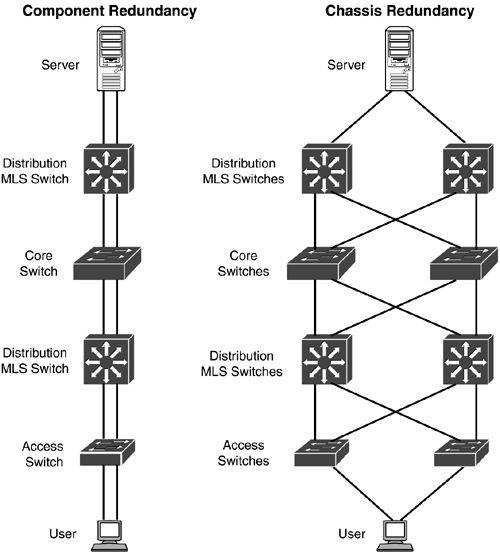Introduction to Availability and Redundancy
| There are two methods of providing basic redundancy services: chassis redundancy and component redundancy. Chassis redundancy has another networking device, with the same functionality, that provides redundant services in case the primary device fails. Component redundancy provides for redundant components inside the same chassis. Six key components are used to reach a high level of availability (as close to 100% as possible):
Of the preceding bullet points, the most important is the creation of a network design that minimizes any weak points by providing an appropriate level of redundancy. In other words, it is sometimes too costly, and unnecessary, to provide 100% redundancy. The important point is that you need to rank your networking resources from critical to nonessential, and then determine what level of redundancy is needed and what type of solutions you should use to provide that redundancy. The following two sections discuss the two approaches that can be used to provide redundancy.
Component RedundancyOne type of redundancy is component redundancy. This type of redundancy provides protection against component failures inside the same chassis. Components that can be protected in some Catalyst switches include Supervisor Engines, modules (hot-swappable), power supplies, and fans. If you decide to implement only component redundancy (no backup devices), your network would look something like the one shown on the left side of Figure 7.1. Notice that there are no redundant devices in this example. However, there are redundant connections between the devices, which you can see in the figure, and redundant components within those devices. Figure 7.1. Component versus chassis redundancy.
Using a component redundancy design provides these benefits:
However, there are downsides to using only component redundancy:
Chassis RedundancyChassis redundancy provides redundant networking devices. An example of this is shown on the right side of Figure 7.1. In this example, there are redundant switches at each layer of the design. Enhanced STP features are used to provide quick STP convergence in case of a Layer 2 failure, and an intelligent routing protocol such as OSPF or EIGRP provides quick Layer 3 convergence. This type of design provides the following advantages:
Given these advantages, there are two main disadvantages to chassis redundancy: You need more data link layer connections, and because there are more devices, managing and troubleshooting this kind of network is much more difficult than with component redundancy. It's important to point out that a well-designed redundant solution can include both types of redundancy. Remember that you need to determine what level of redundancy is required for the different components in your network. |
EAN: 2147483647
Pages: 171
